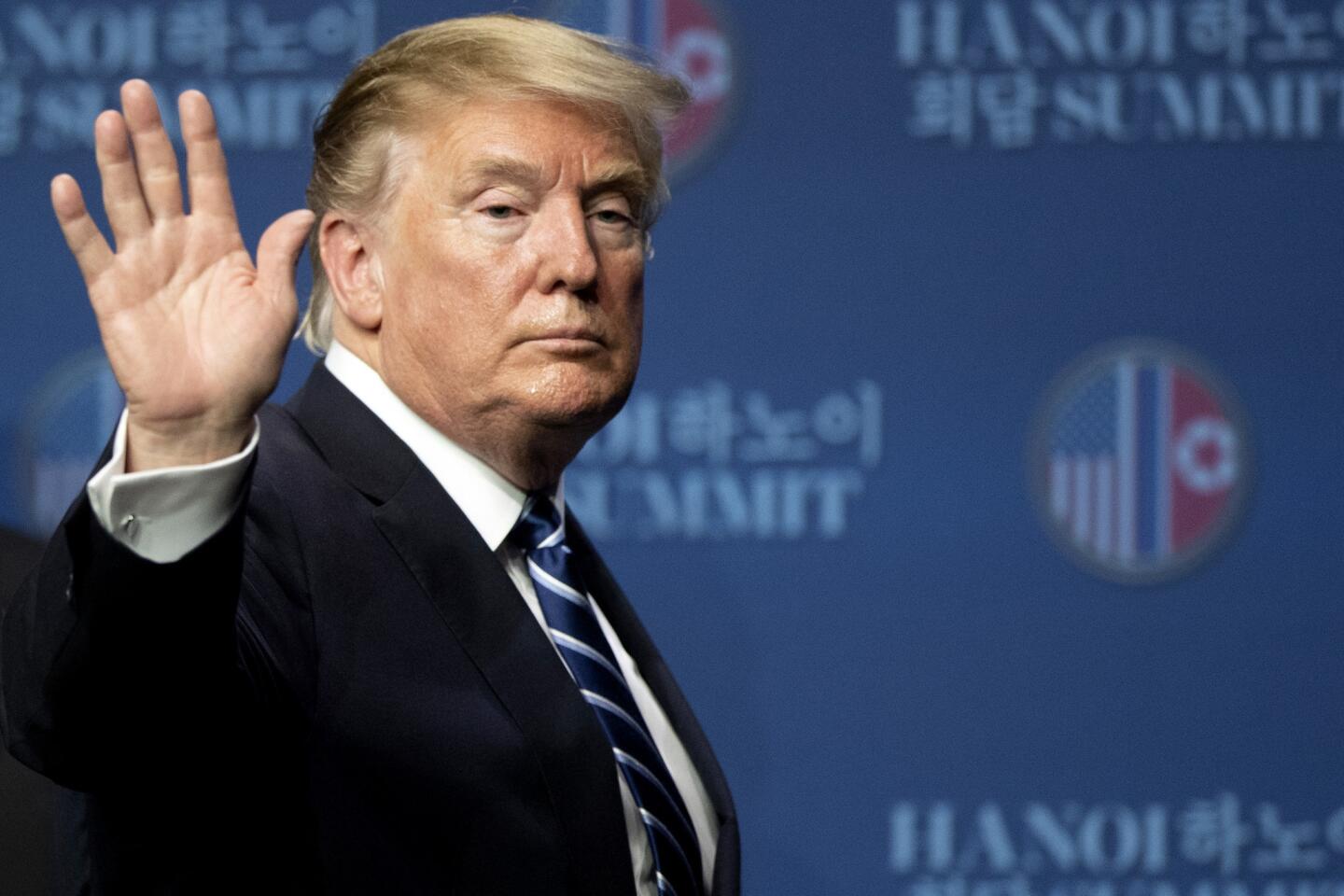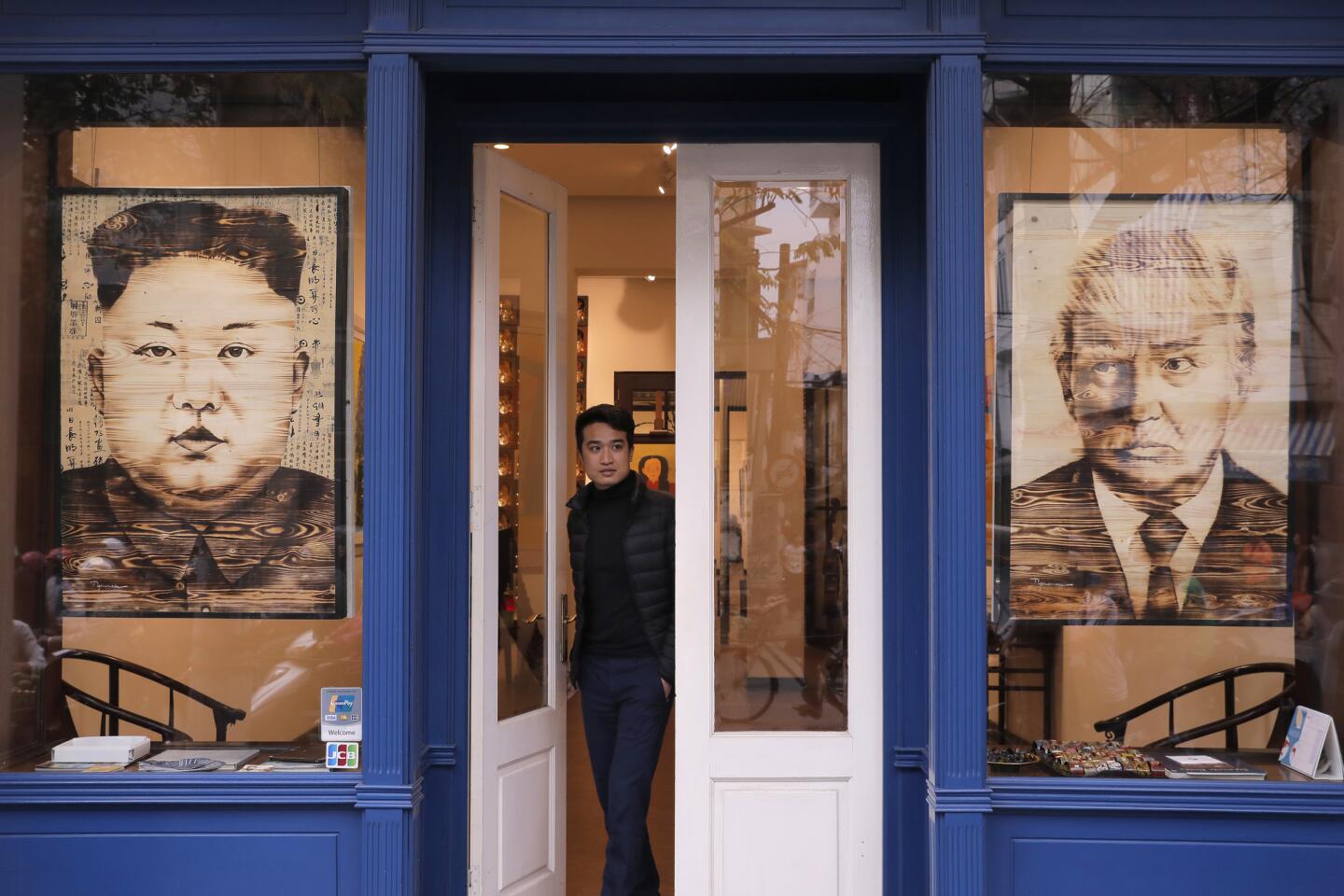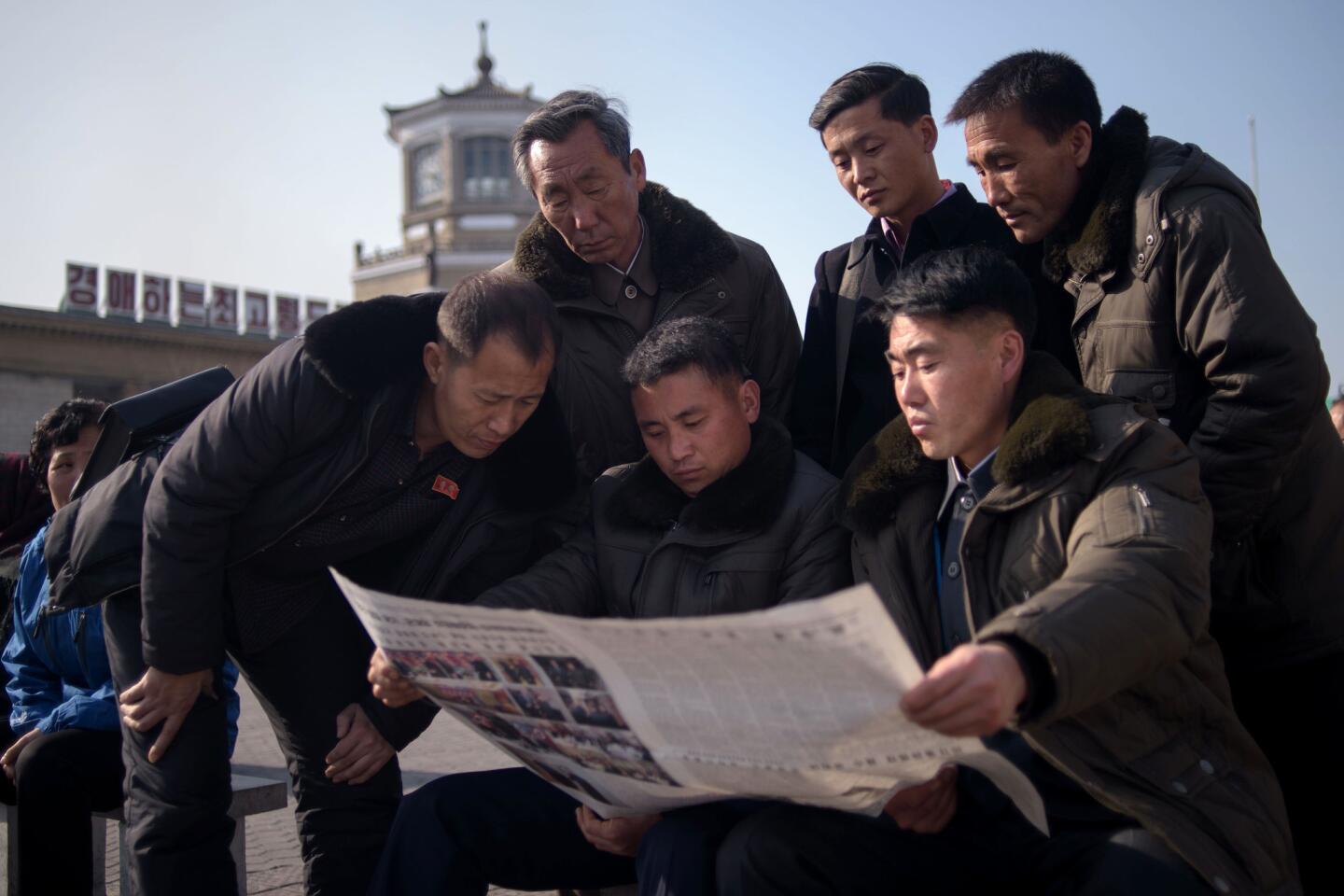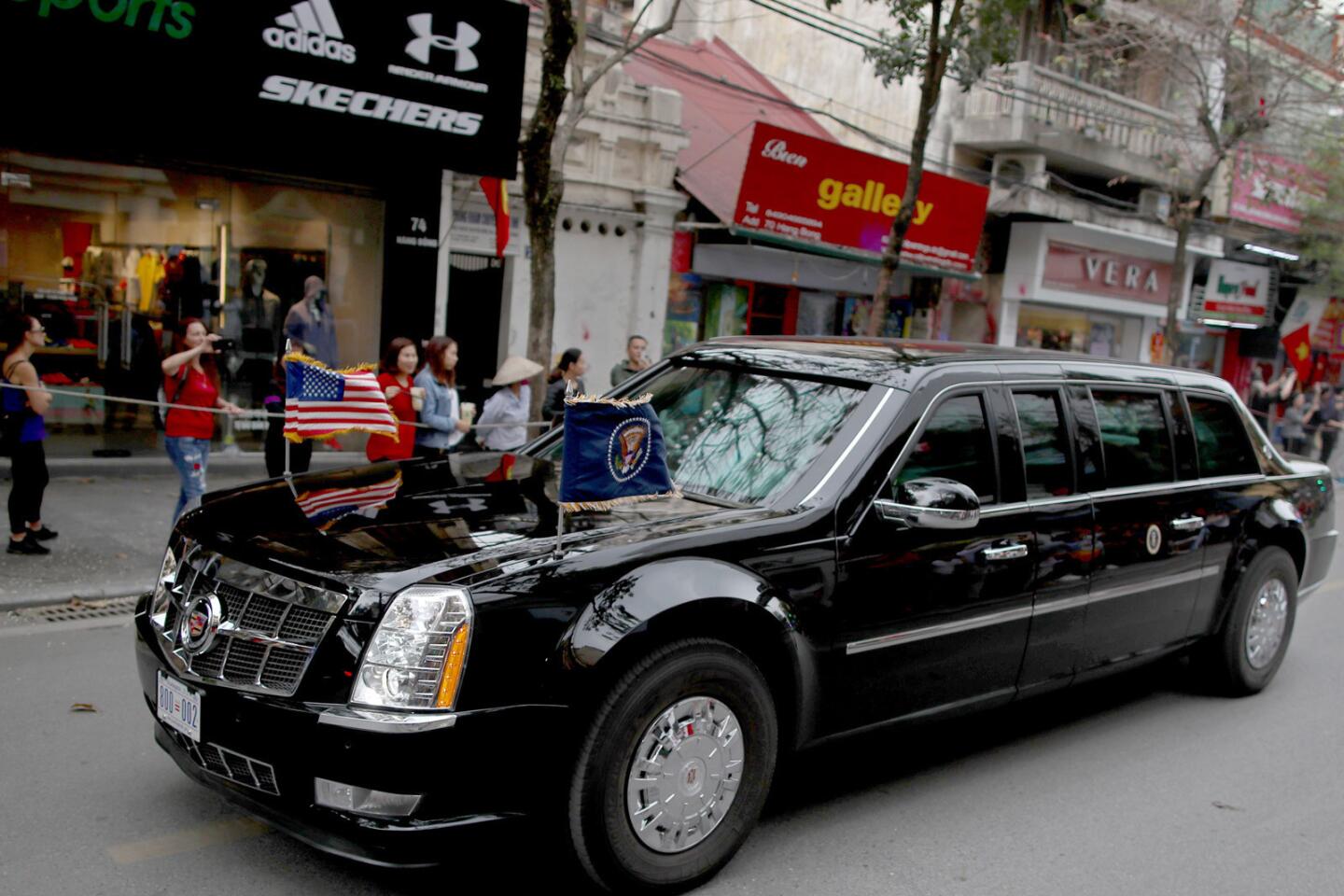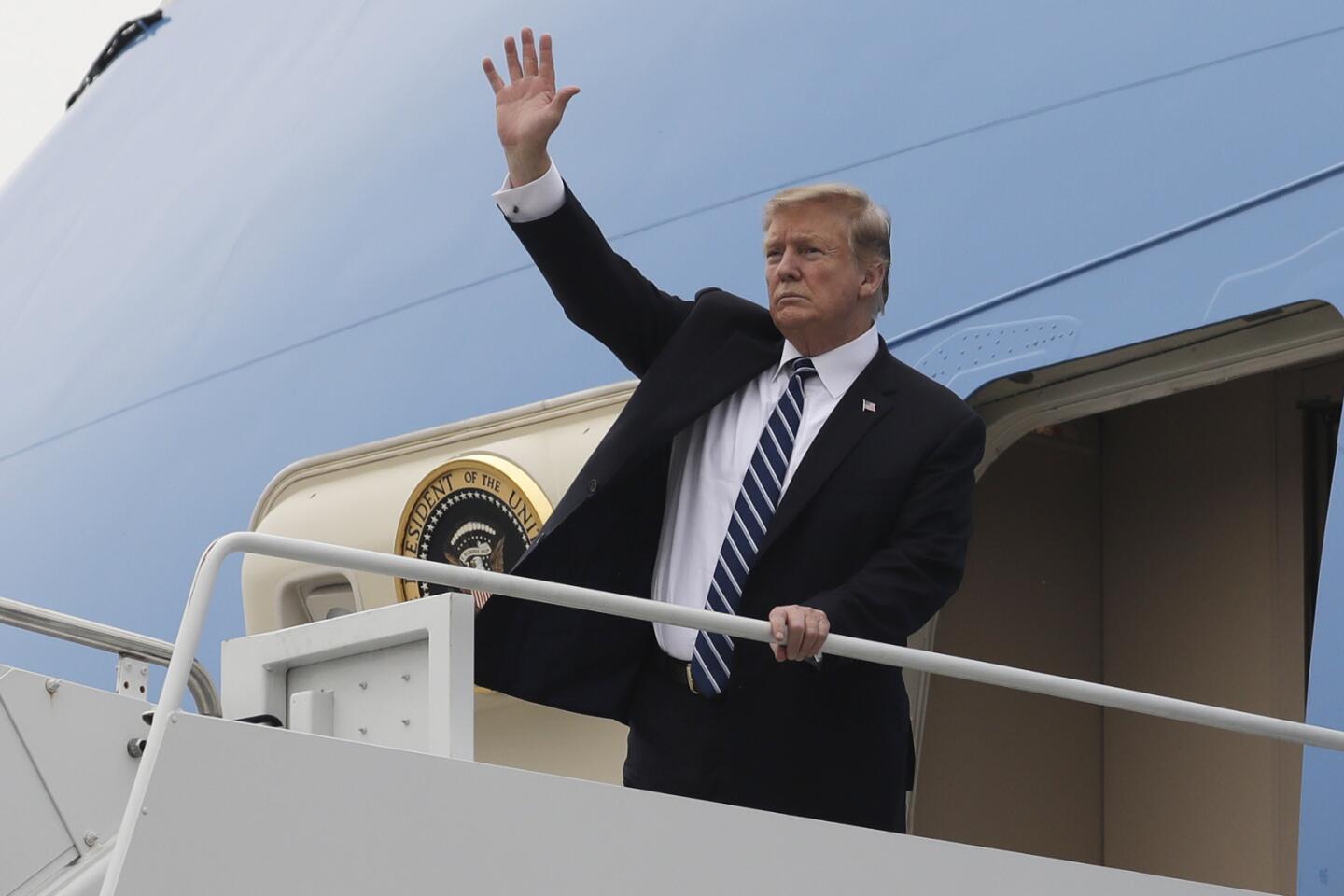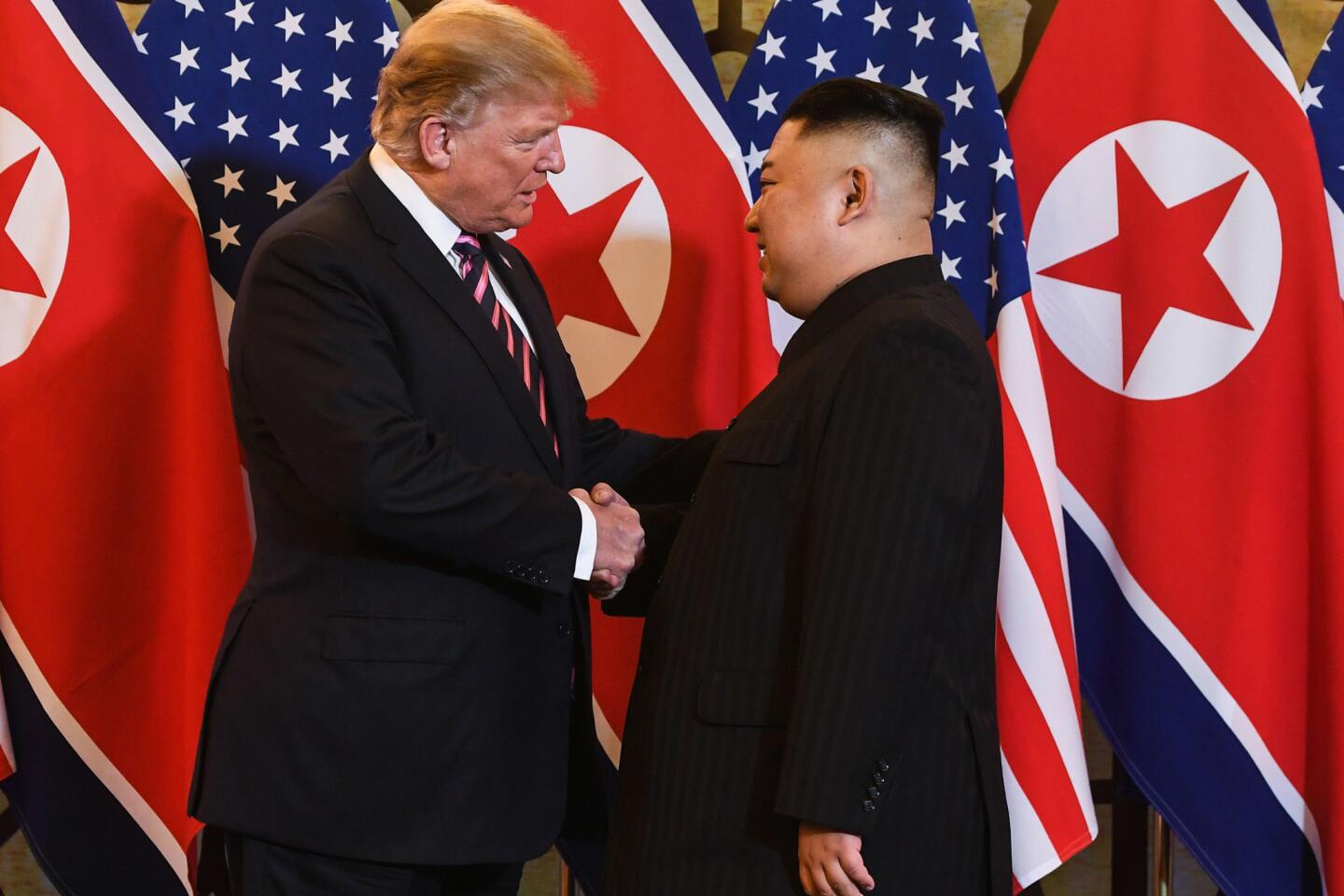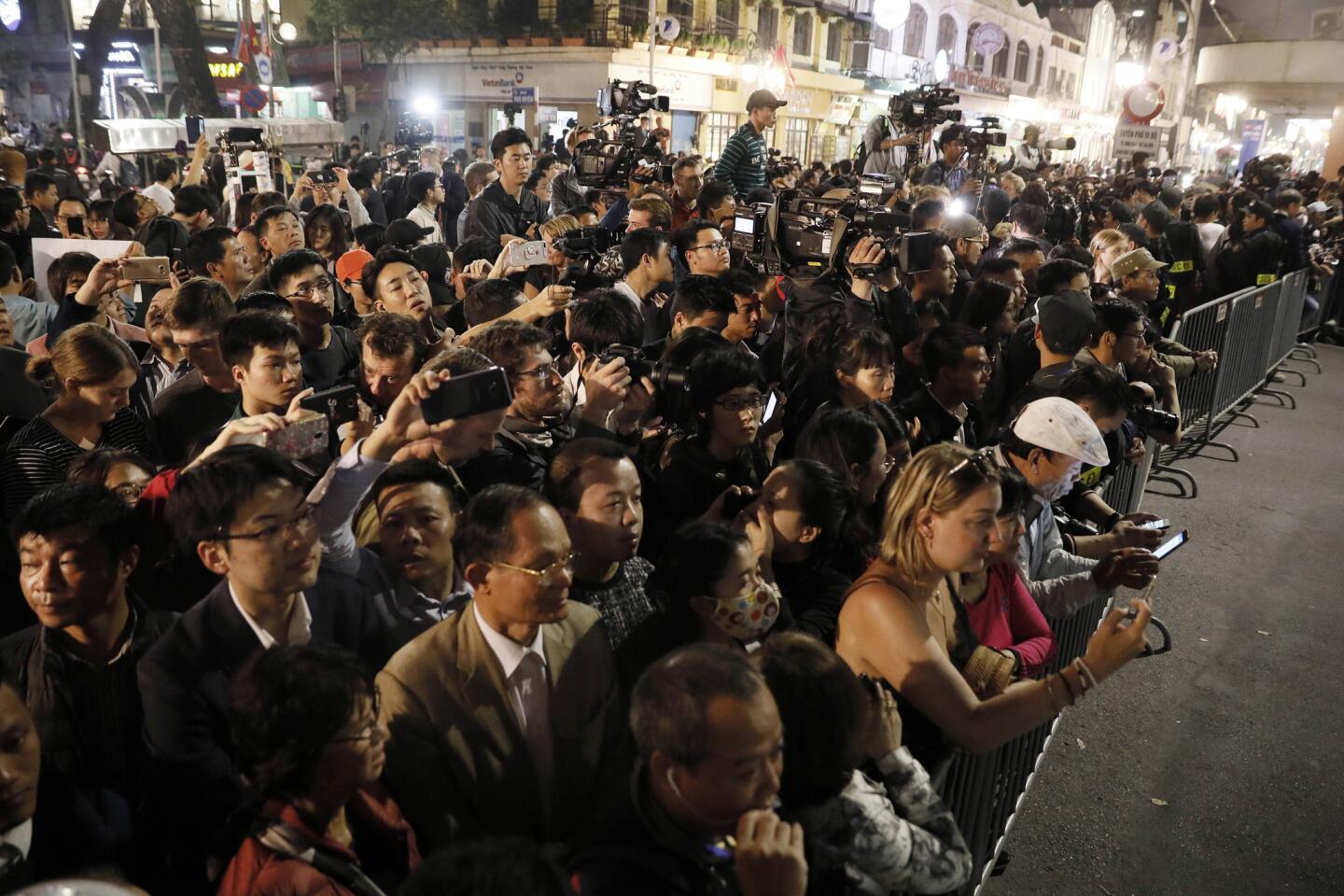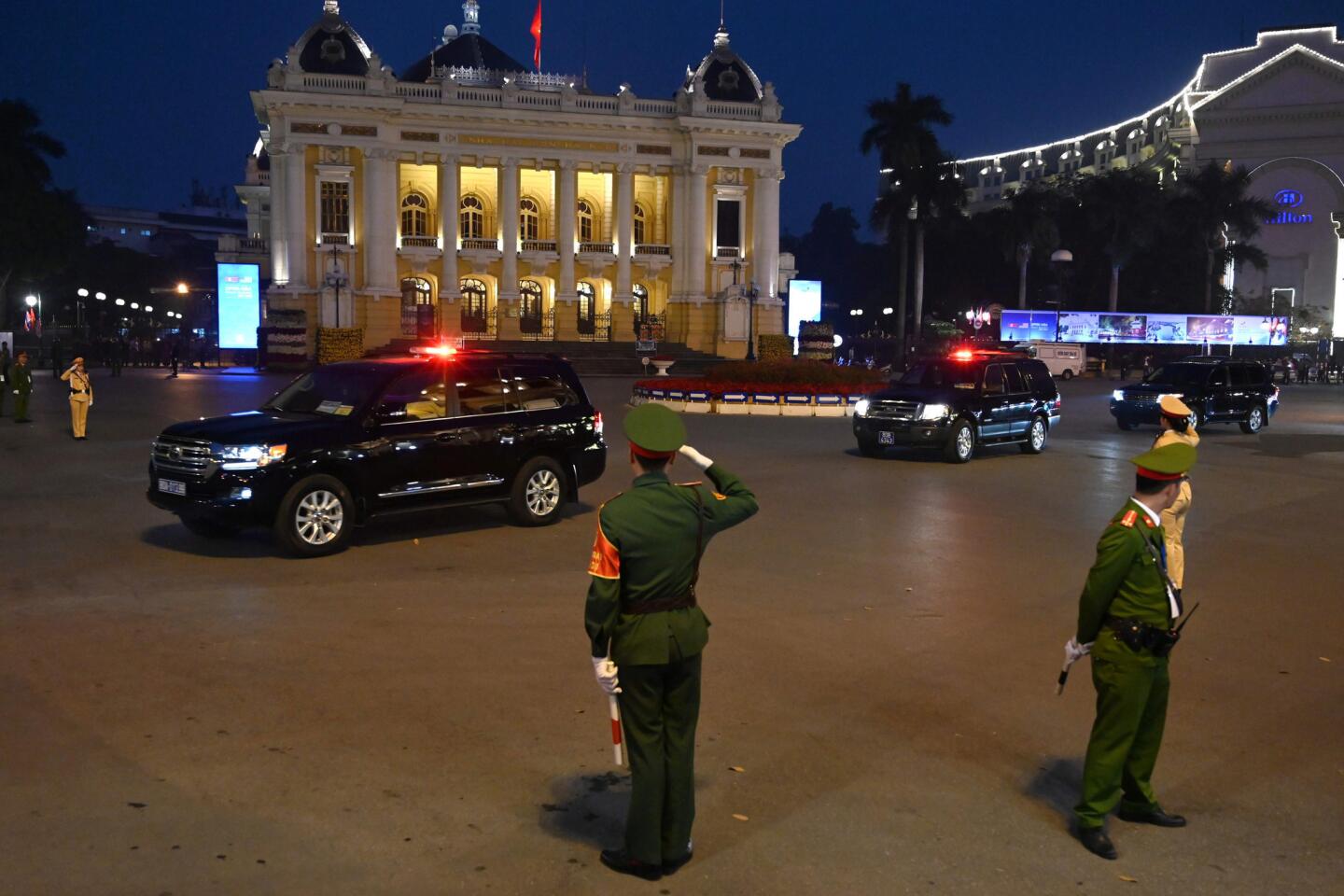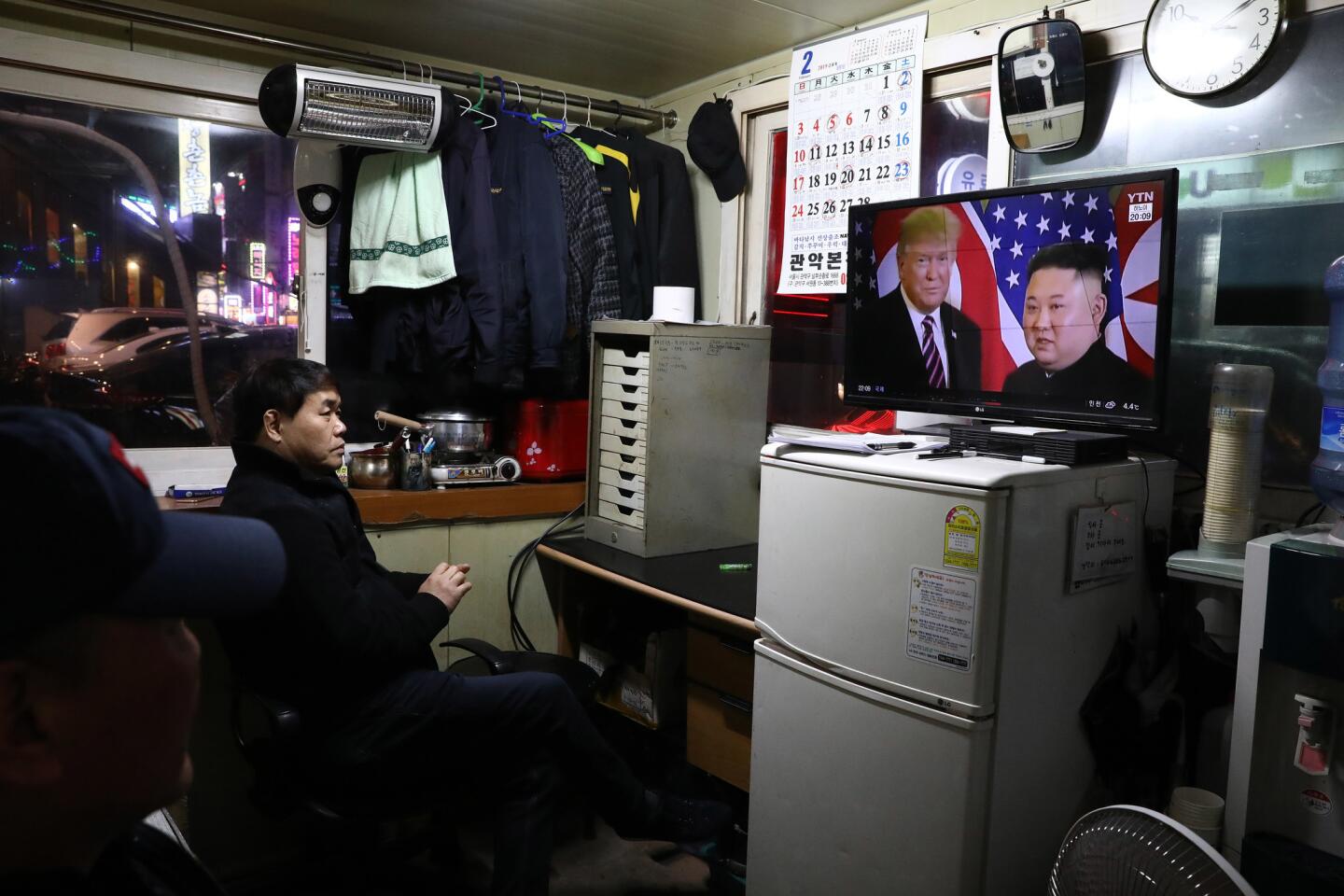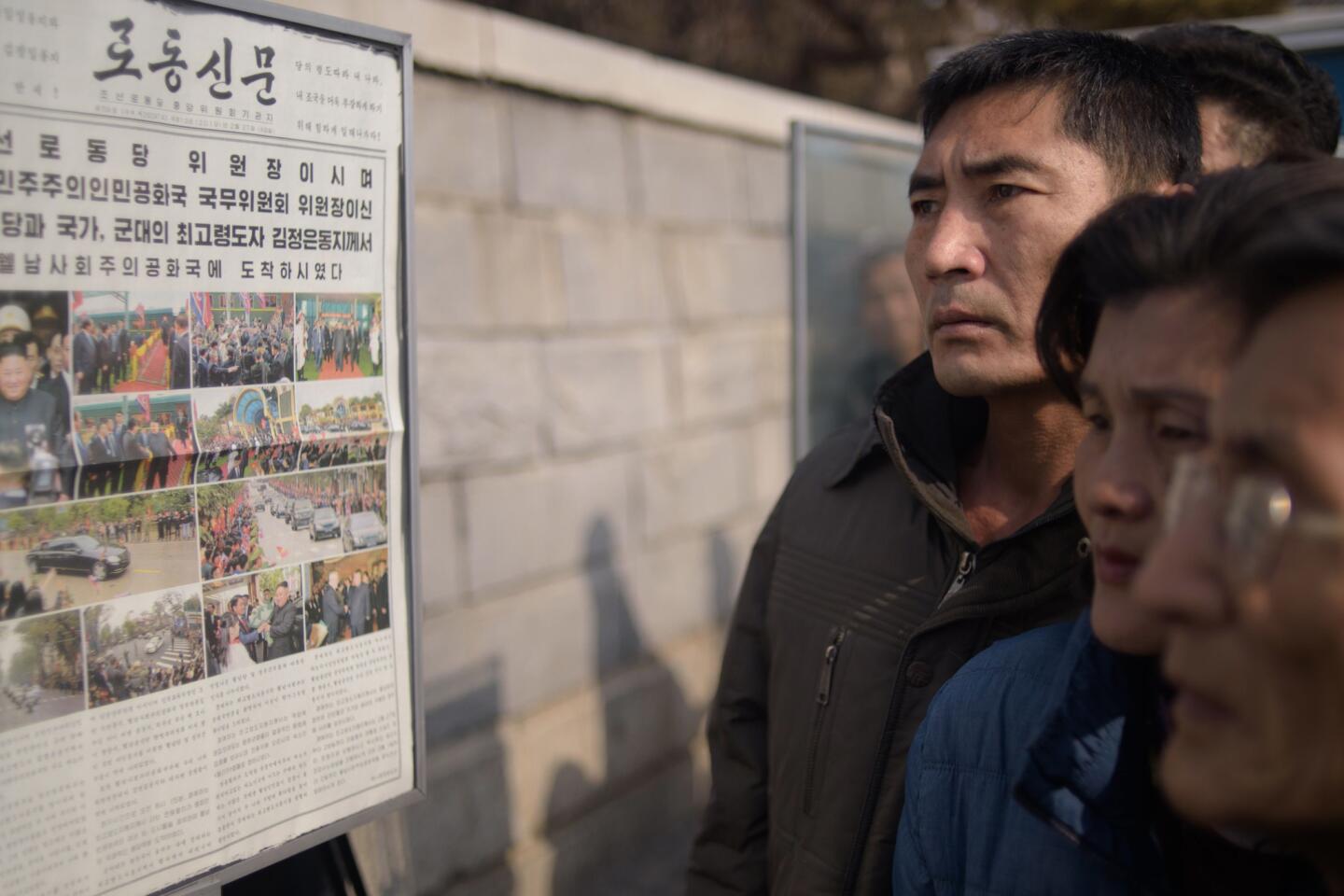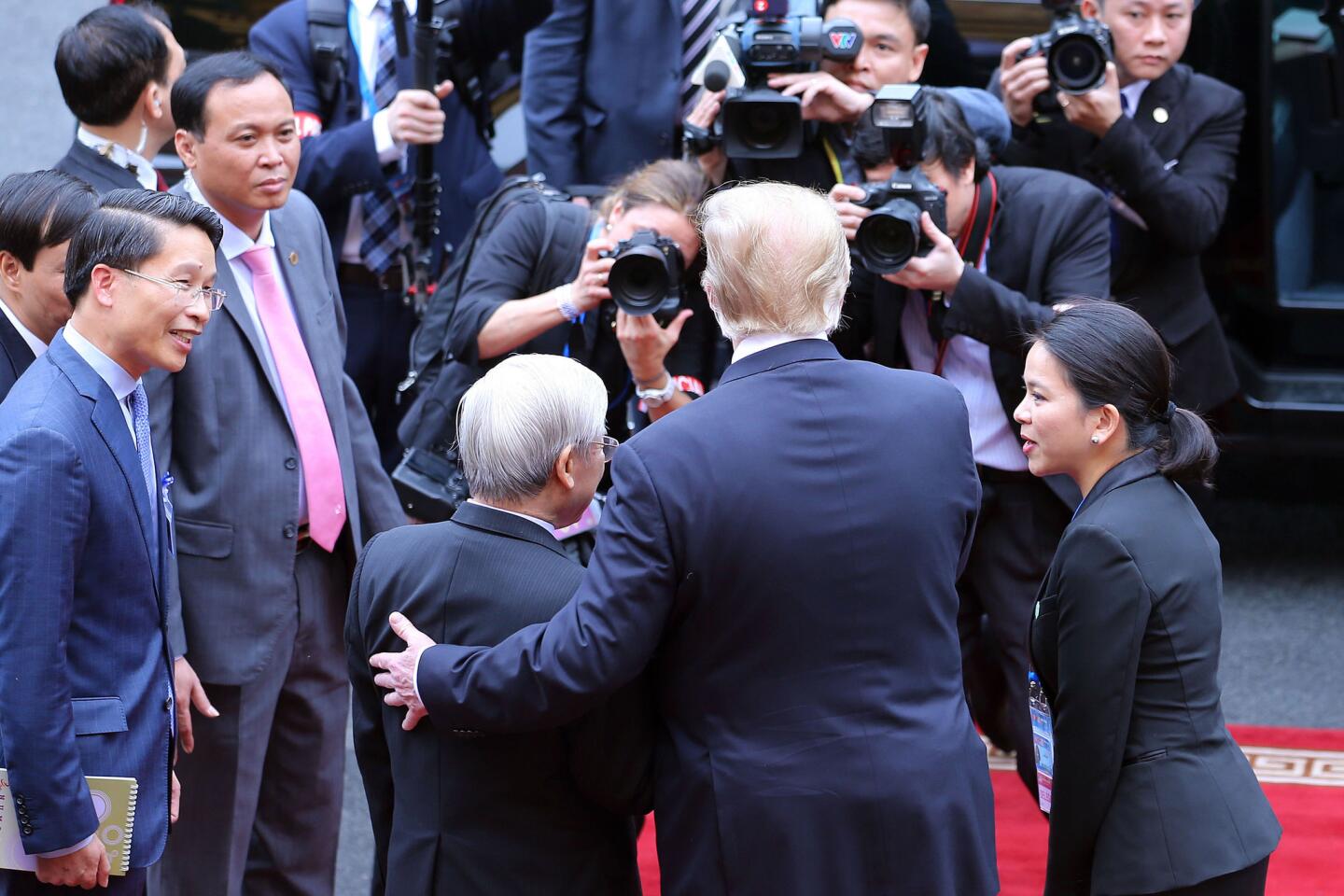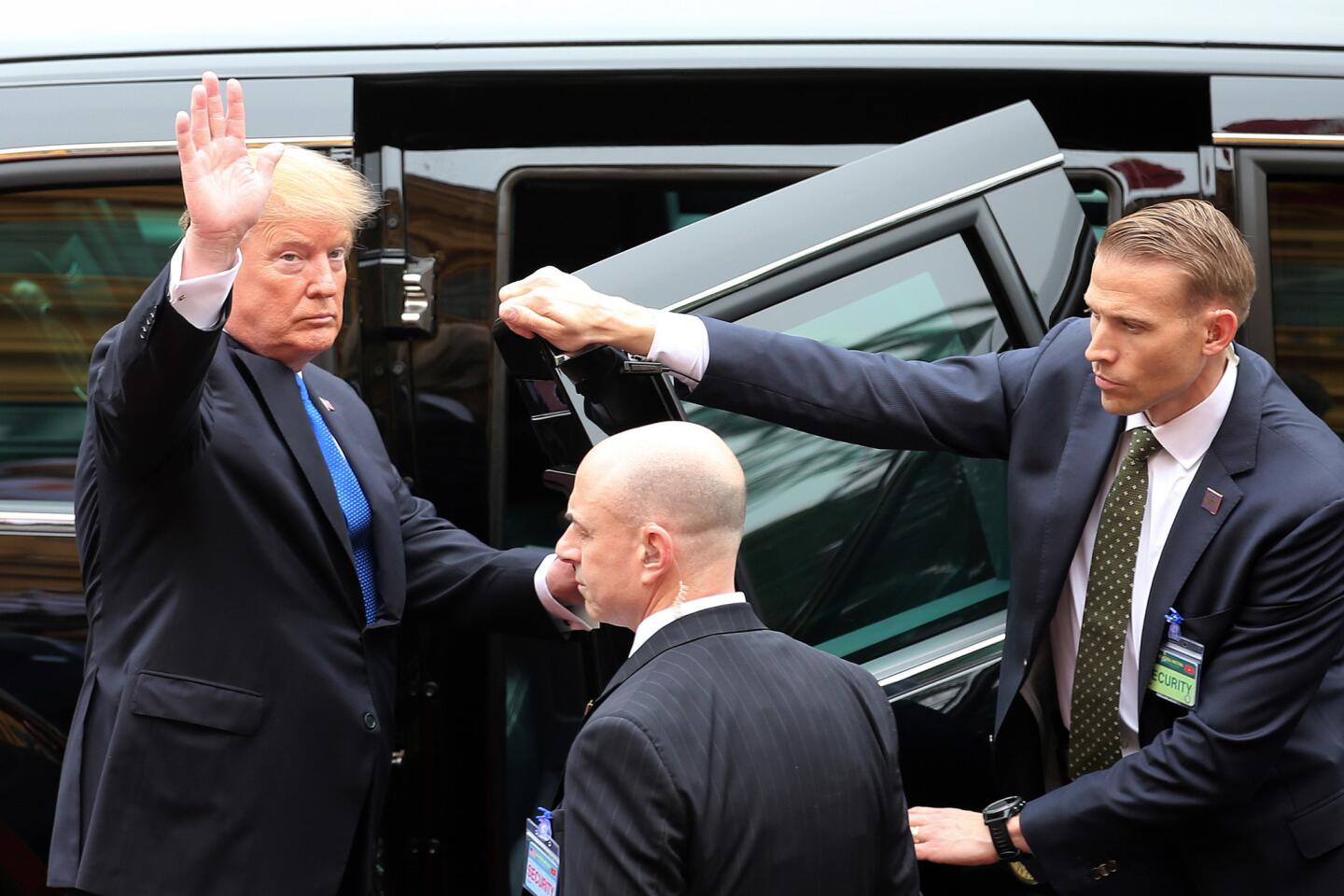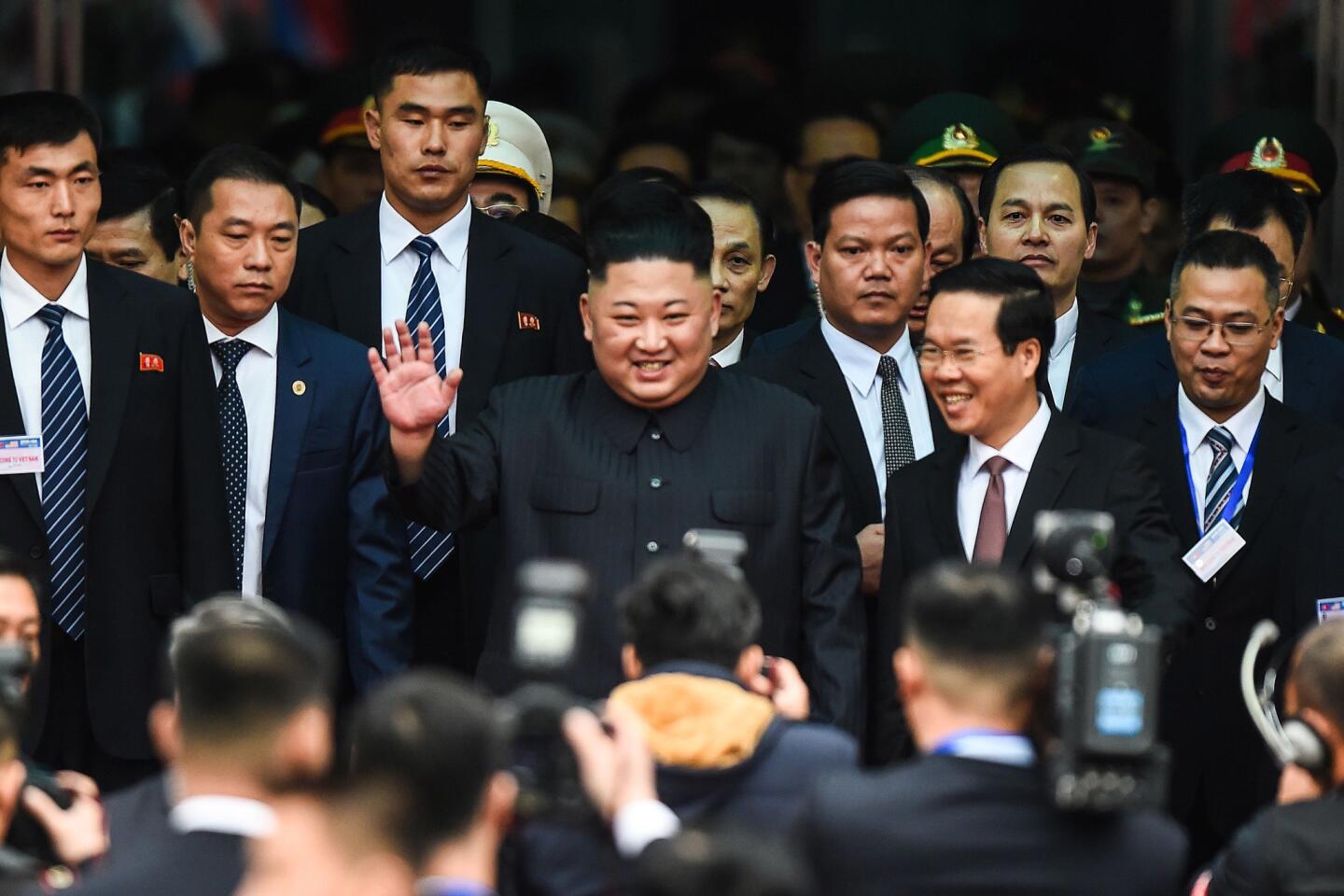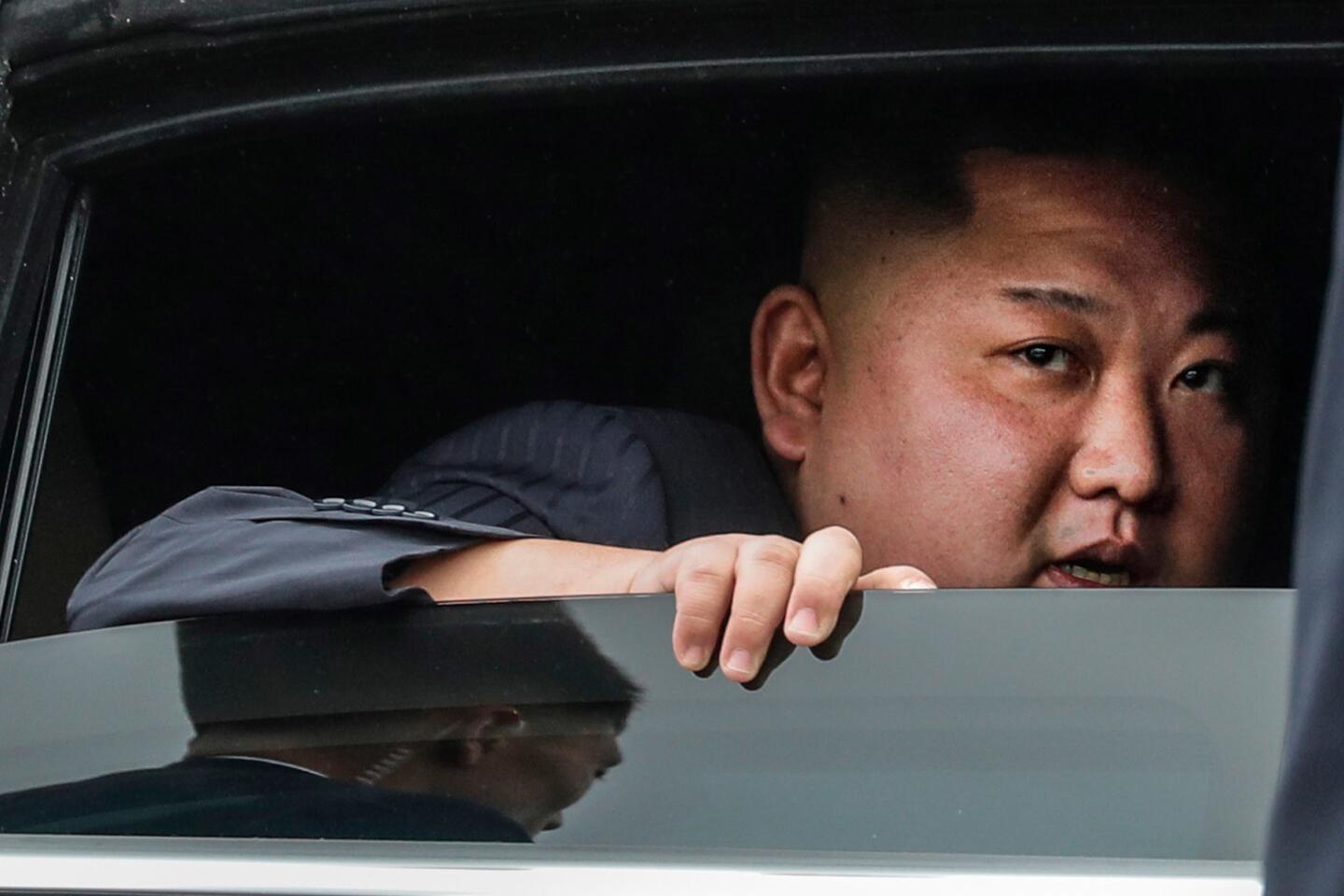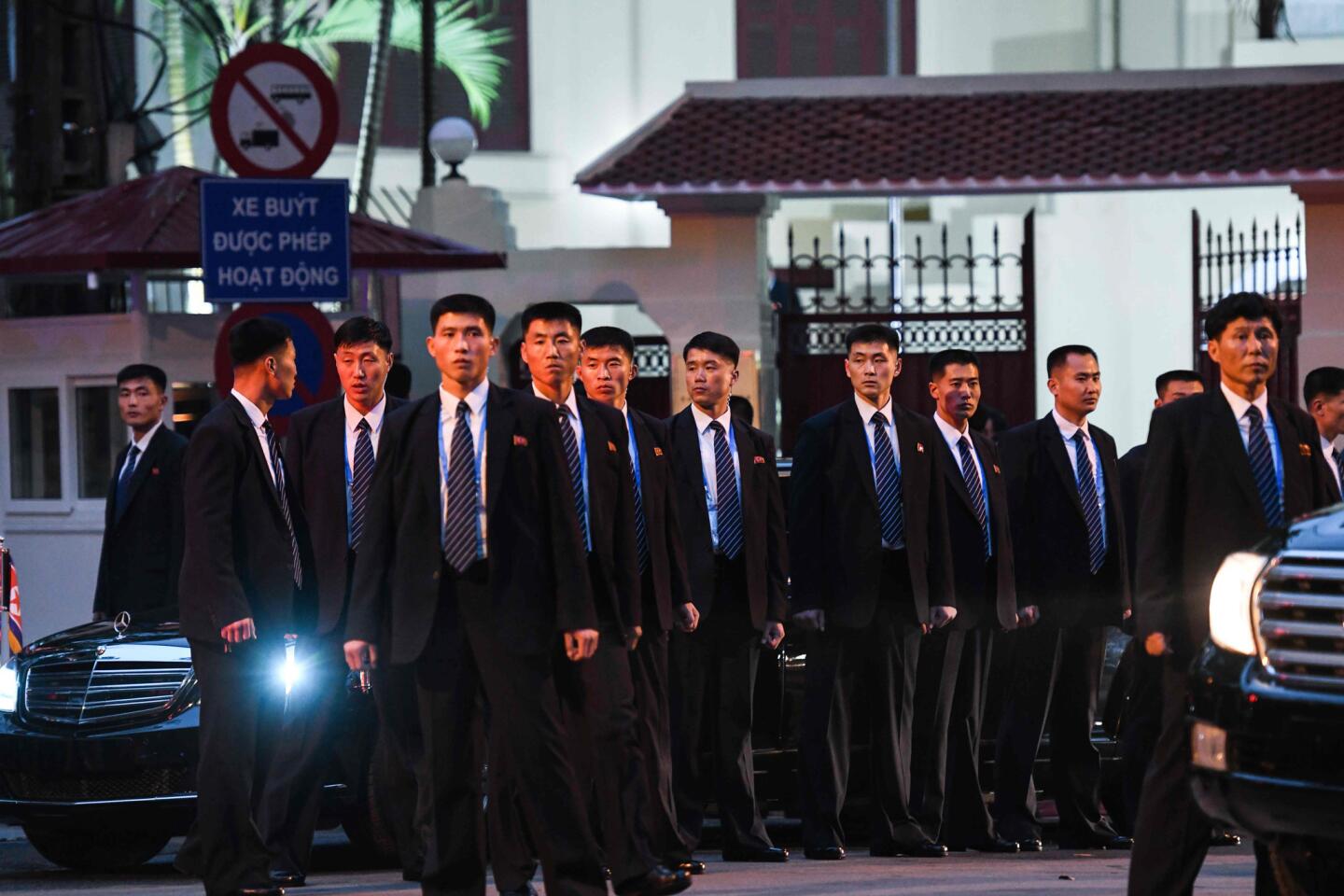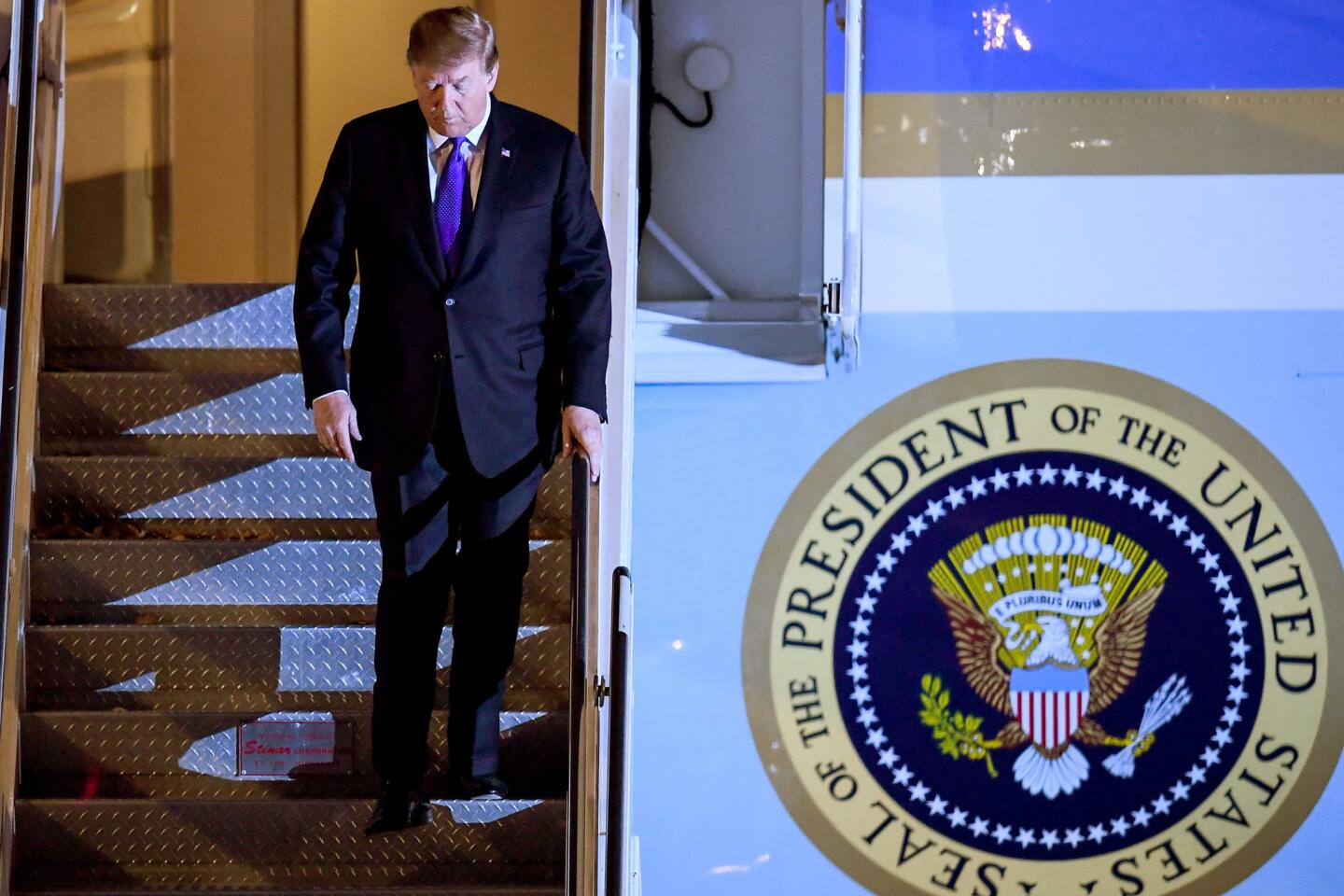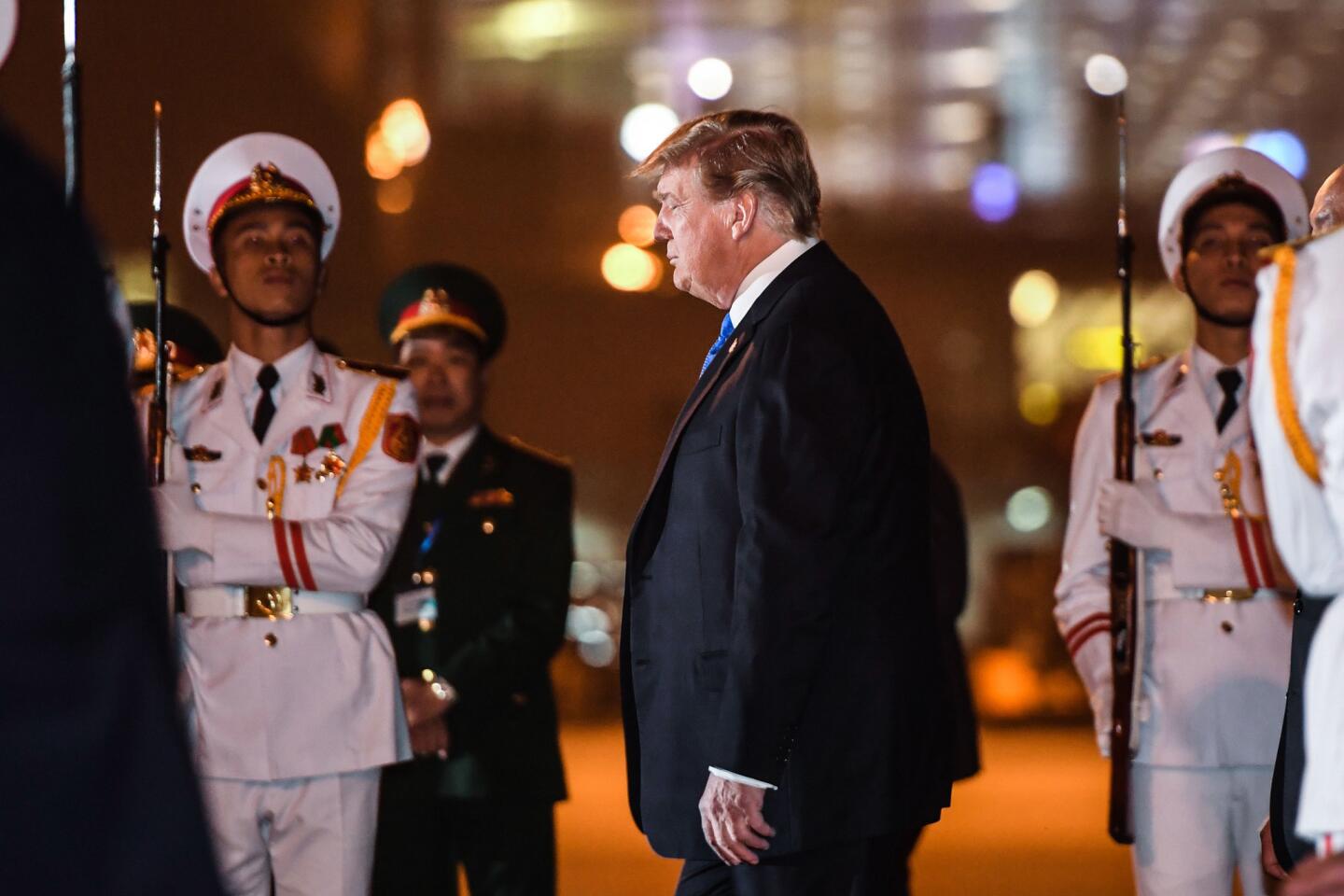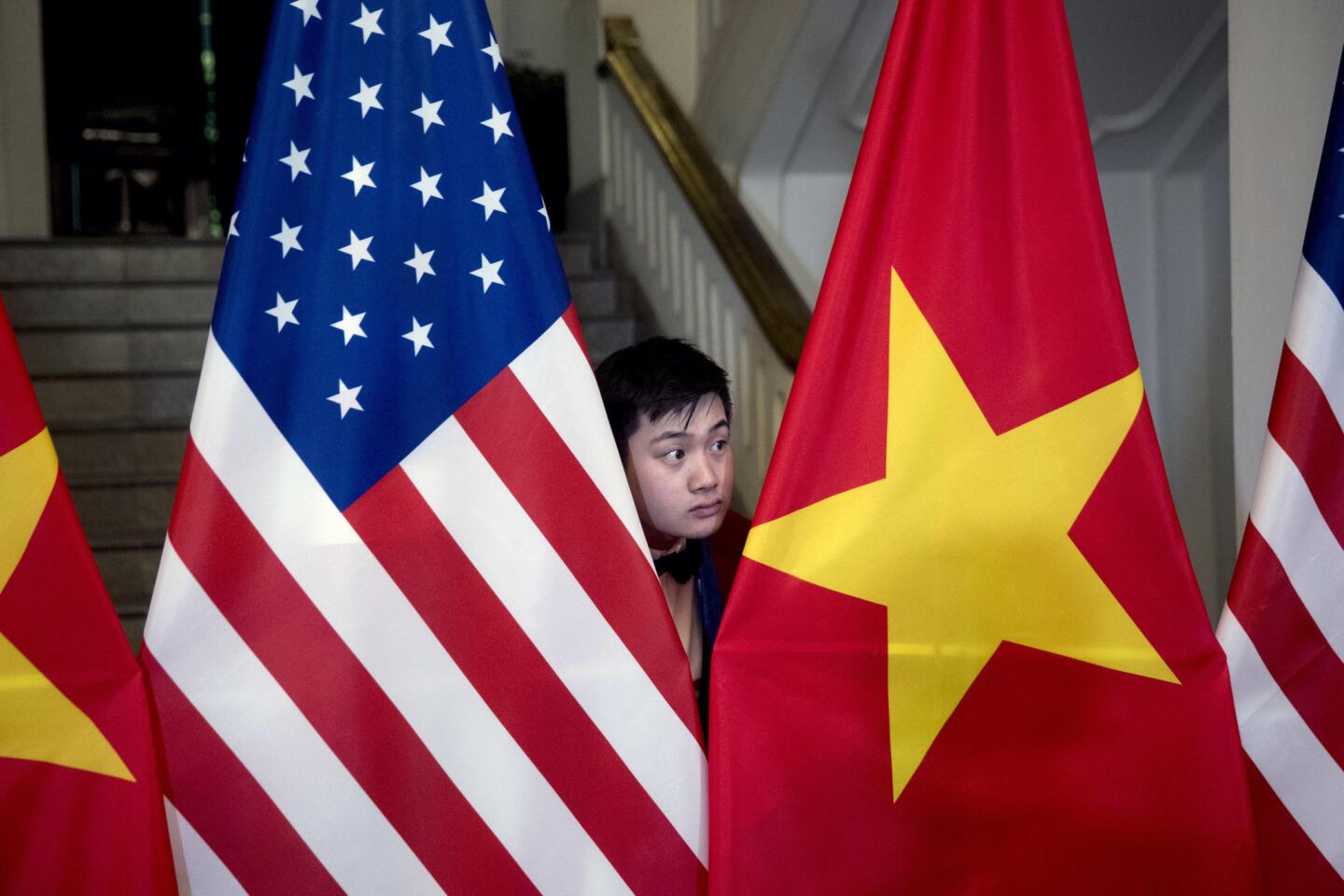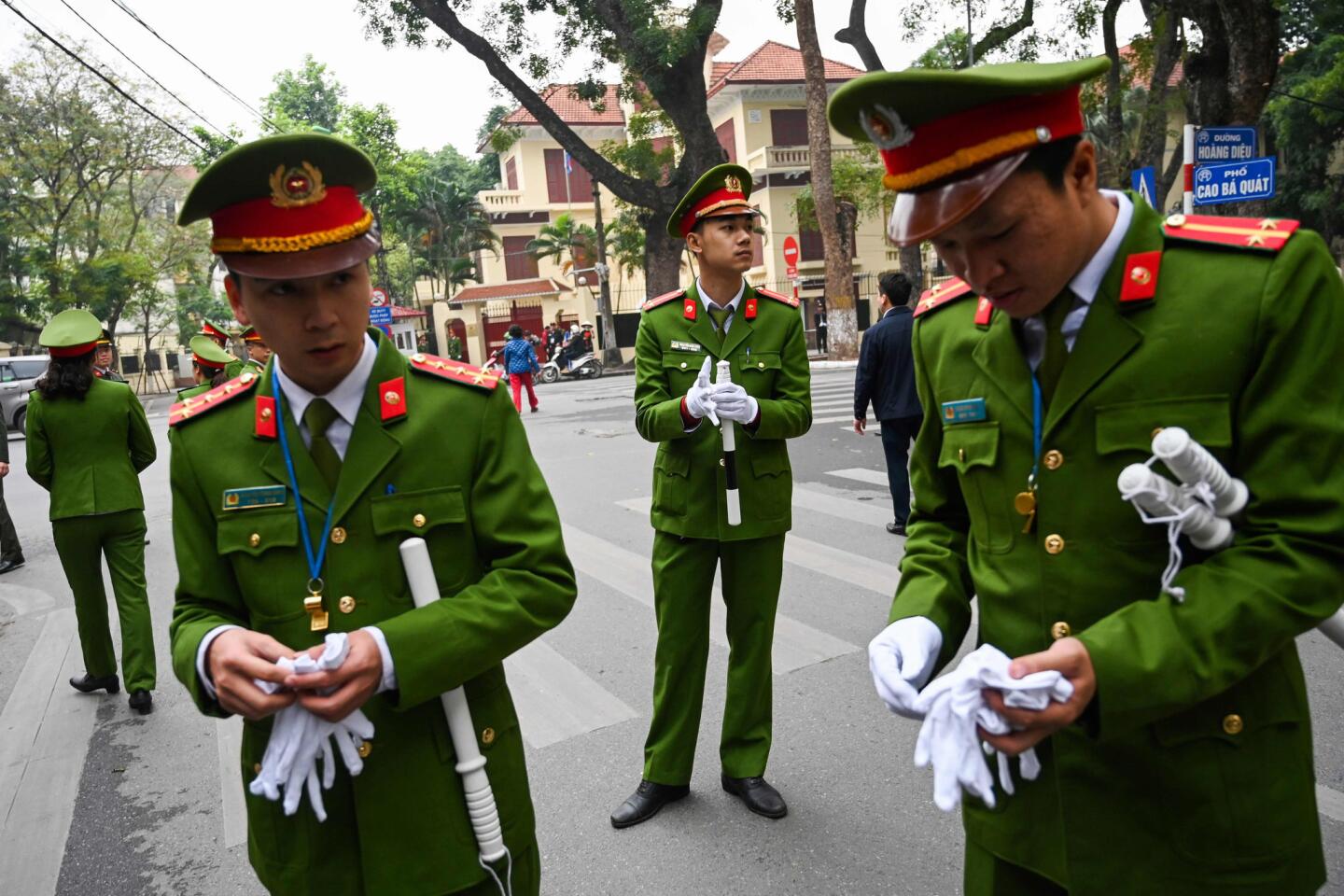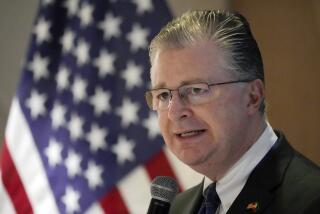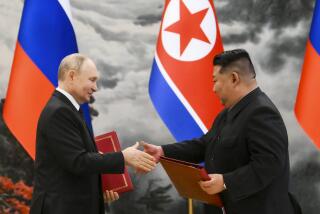In Vietnam, Trump and Kim Jong Un find symbolism, history — and a shared goal of keeping the press at arm’s length
- Share via
Reporting from Hanoi — The armored train, painted military green with yellow trim, lumbered across the Chinese border and pulled to a stop at Vietnam’s Dong Dang railway station. Under gray, chilly skies, a beaming Kim Jong Un stepped out of his customized carriage Tuesday morning and onto a red carpet lined with bouquets of red flowers.
The reclusive North Korean leader’s journey to his second summit with President Trump, which begins Wednesday in the Vietnamese capital, Hanoi, had taken 2½ days to cover more than 2,000 miles. It was steeped in symbolism for the young dictator, mirroring the travels of his grandfather and North Korea’s founder, Kim Il Sung, who rode the rails to Vietnam for state visits more than half a century ago.
Trump landed in Hanoi on Air Force One also trying to evoke history: Four decades after fighting a long, bloody war, the U.S. has forged a friendship with Vietnam, an authoritarian state with a booming, capitalist-oriented economy that the White House says North Korea could emulate — if it ends its nuclear weapons program and claws its way out of international isolation.
“Vietnam is thriving like few places on earth,” Trump tweeted Wednesday morning. “North Korea would be the same, and very quickly, if it would denuclearize.”
But the leaders’ second meeting would have to be about more than symbols. Trump is under pressure to show that his outreach to Kim — whom he called “my friend” — could produce concrete progress. Their high-profile June summit in Singapore yielded only fuzzy promises from Kim to denuclearize, and no timeline to achieve them.
Trump was scheduled to have dinner with Kim and a few close aides Wednesday before a series of meetings Thursday. Both men received a warm welcome in Vietnam, which sees the summit as a chance to cement its reemergence on the world stage.
“Thank you to all of the people for the great reception in Hanoi,” Trump tweeted. “Tremendous crowds, and so much love!”
Kim, who borrowed a Chinese jet to travel to Singapore but generally avoids flying, reportedly because of security fears, shook hands with Vietnamese officials in Dong Dang and waved to a crowd of hundreds, many holding North Korean flags.
Then he climbed into the back seat of a waiting Mercedes stretch limo with no license plate, driving off in the direction of Hanoi and trailed by a convoy of SUVs and black sedans.
According to the news website VN Express, Kim thanked a Vietnamese government minister “for a warm and enthusiastic welcome.”
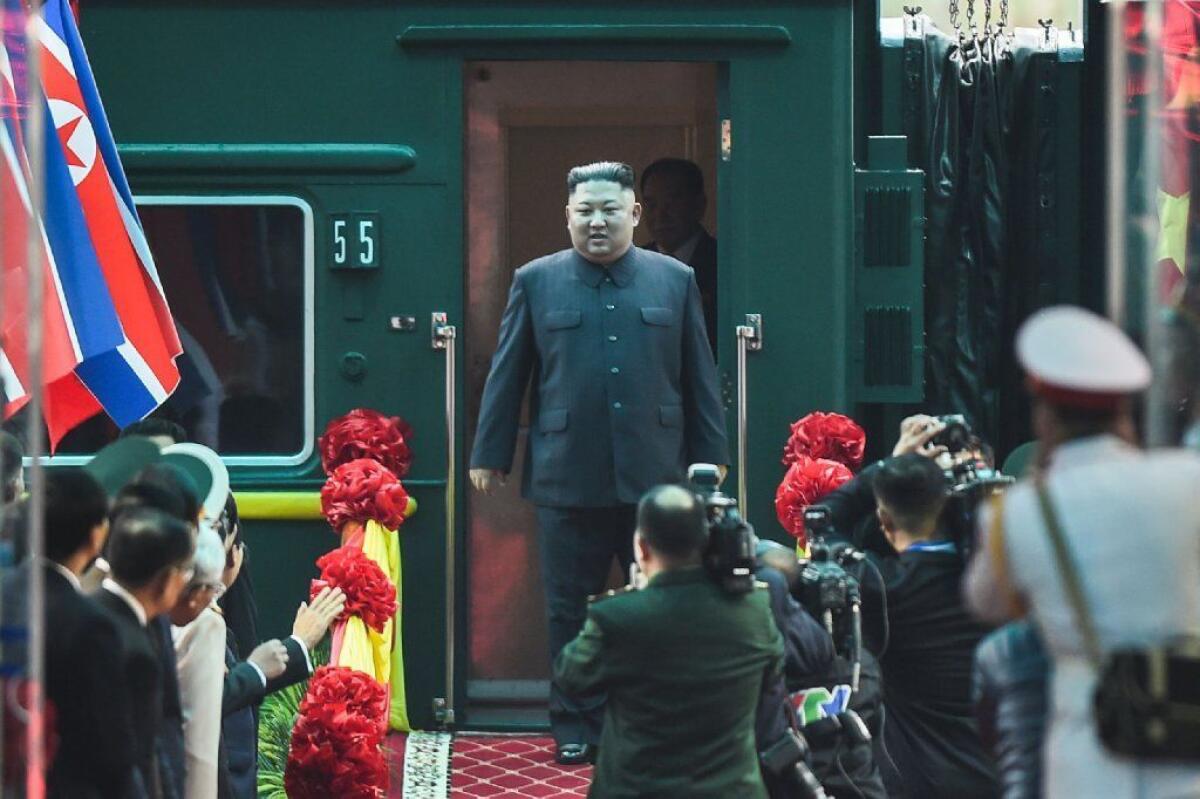
Less than three hours later, Kim’s motorcade reached Hanoi’s five-star Melia Hotel, which had been seen as the North Korean delegation’s likeliest choice of accommodation after Kim’s de facto chief of staff, Kim Chang Son, was spotted there last week.
The choice came with a built-in conflict: The White House had reserved accommodation there for TV camera crews and set up a dedicated news media center inside a ballroom for several hundred credentialed journalists traveling from the United States.
That set up a clash between the White House press corps and a dictator used to total control. Since this round took place in Vietnam, a one-party state that does not allow an independent domestic press, the outcome was not in doubt: North Korea got its way. A day earlier, Vietnamese authorities had deported an Australian man who works as a Kim Jong Un impersonator, whom they said had an invalid visa.
On Tuesday morning, hours before Kim arrived in Hanoi, the White House travel office, which handles logistics for reporters covering Trump’s foreign trips, abruptly announced that it was relocating the news media center “due to technical issues.”
The move was believed to have come at North Korea’s request. The travel office was informed about 5 a.m. Tuesday, one official said, without elaborating.
Correspondents staying at the hotel were not ordered to check out. But television networks that had taken pains to set up camera and transmission equipment at the Melia were told they could not film there.
As Kim arrived, Margaret Talev, a reporter for Bloomberg news who was at the hotel, tweeted that all guests were cleared out of the lobby, some corralled into a restaurant, and window shades were pulled down.
“Security forces prohibited us from taking pictures from inside the hotel though we could see (state?) camera rolling on [Kim] as his entourage rolled through,” Talev wrote. “Guards were literally right up on us saying no cameras.”
It was unclear whether the White House or Kim’s delegation had booked the Melia first. But the last-minute change was emblematic of a summit that had been planned seemingly on the fly, with Vietnamese officials saying they had 10 days to make security and other arrangements in Hanoi.
Vietnamese officials said nearly 3,000 foreign journalists from 40 countries had registered to cover the summit. The government set up a news media center with around-the-clock catering including Vietnamese specialties such as pho and egg coffee.
Later Tuesday afternoon, Kim visited the North Korean Embassy in Hanoi about a mile away from his hotel. Loud cheering and applause erupted from inside the building, audible in South Korean news reports that captured the young leader’s visit.
He left about an hour later and returned to his heavily guarded hotel as dusk fell.
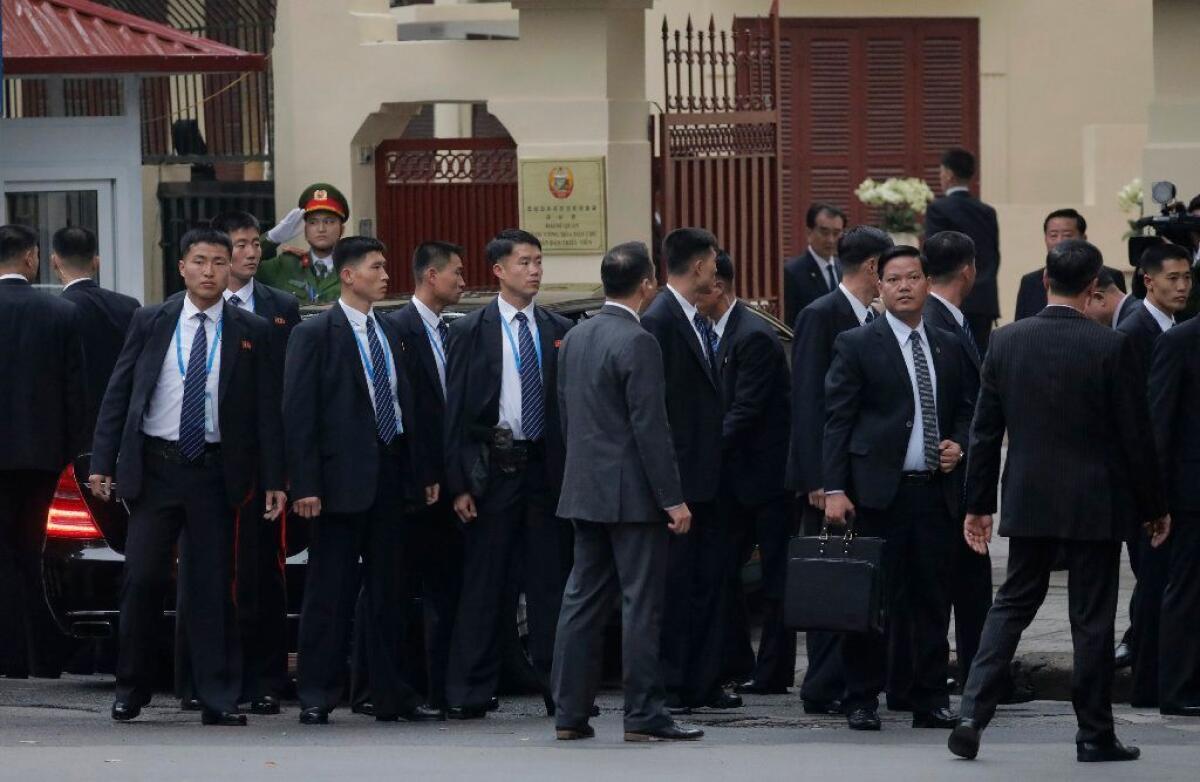
The White House has kept many details of the summit schedule under wraps. On Tuesday, Trump’s press secretary, Sarah Huckabee Sanders, said the president and Kim would have a brief one-on-one greeting Wednesday evening followed by a “social dinner” that would include Secretary of State Michael R. Pompeo, acting White House Chief of Staff Mick Mulvaney, Kim’s close aide Kim Yong Chol and another North Korean official.
The two leaders are then expected to hold formal meetings Thursday before Trump returns to Washington.
Whether those meetings lead to substantive accomplishments remains very much up in the air. At the Singapore summit, Kim made vague pledges to denuclearize while Trump called off military exercises with South Korea, a longtime U.S. ally, a concession to North Korea that caught Seoul and the U.S. military by surprise.
Since then, Pyongyang has refrained from conducting further nuclear tests but made no progress on dismantling its nuclear facilities or producing a full accounting of its nuclear-related sites.
In November, Vice President Mike Pence said that it would be “absolutely imperative” that a second summit produce a plan for identifying all of North Korea’s nuclear sites, opening them up to international inspectors and eventually dismantling them.
In recent weeks, Trump administration officials have tamped down expectations for even that much progress, but insisted that the U.S. was not ready to discuss lifting harsh economic sanctions on North Korea or withdrawing troops from South Korea — two of Kim’s main demands.
“We’ve given up nothing,” Trump said Sunday before departing for Vietnam. “The sanctions are on, everything’s on, but we have a special feeling, and I think it’s going to lead to something very good and maybe now. I think ultimately it will, but maybe not, and I’m not pushing for speed but we’re not removing the sanctions.”
Such comments have left many observers wondering what, if anything, the second summit will accomplish.
“If this second meeting does not produce actual tangible steps — whether it’s on peace, on normalization or on denuclearization — I think it will widely be seen as a failure,” Victor Cha, Korea chair at the Center for Strategic and International Studies, told reporters in a conference call last week.
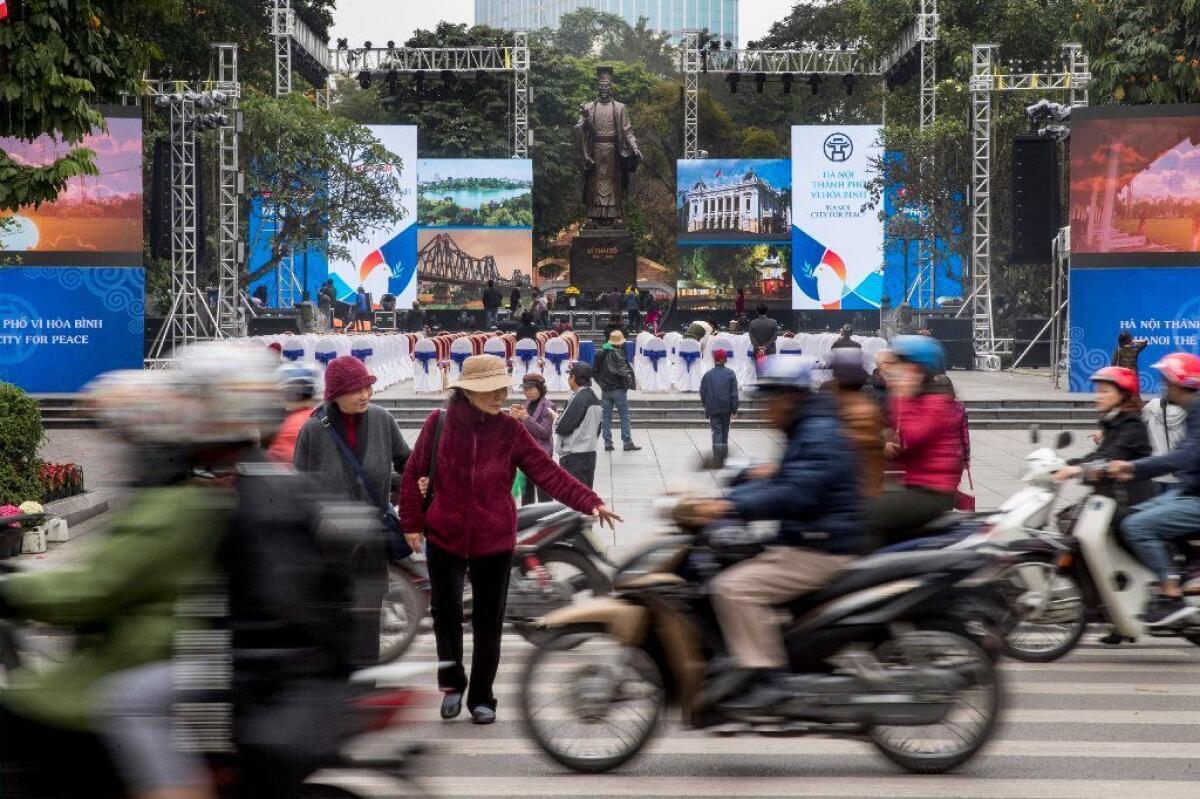
U.S. officials had been keen to hold the summit in the coastal resort city of Danang, which has a large convention center and is easier to secure than Hanoi, a chaotic capital of 8 million people where fleets of honking motorcycles jam the streets — and often the sidewalks.
But Kim preferred Hanoi, where he has an embassy. It is also the city his grandfather visited in 1958 and 1964.
“He has a history here,” said one foreign diplomat who spoke on condition of anonymity, citing diplomatic protocol. “Hanoi was not the Americans’ preference. But in the end they went along with it.”
The leaders were scheduled to meet Wednesday at the graceful, colonial-era Metropole hotel in the heart of Hanoi. On Tuesday, inside the colonnaded portico, Vietnamese guards frisked visitors as plainclothes American security personnel wearing earpieces milled about the wood-paneled lobby.
Out back by the palm-fringed swimming pool, as tourists sipped gin cocktails, Vietnamese security personnel in camouflage uniforms waved metal detectors in the bushes.
Touting its transition from poverty and diplomatic isolation in the 1970s, Vietnam has embraced the role of host, rolling out security forces and armored personnel carriers around the summit venues while festooning the surrounding streets with U.S., North Korean and Vietnamese flags. On the road leading to the Melia, which was closed to traffic, posters proclaimed Hanoi “the city for peace.”
Around Hanoi’s Old Quarter, where tourists in oversized backpacks and fruit vendors wearing conical hats bustled along the sidewalks, shopkeepers were eager to capitalize on summit fever.
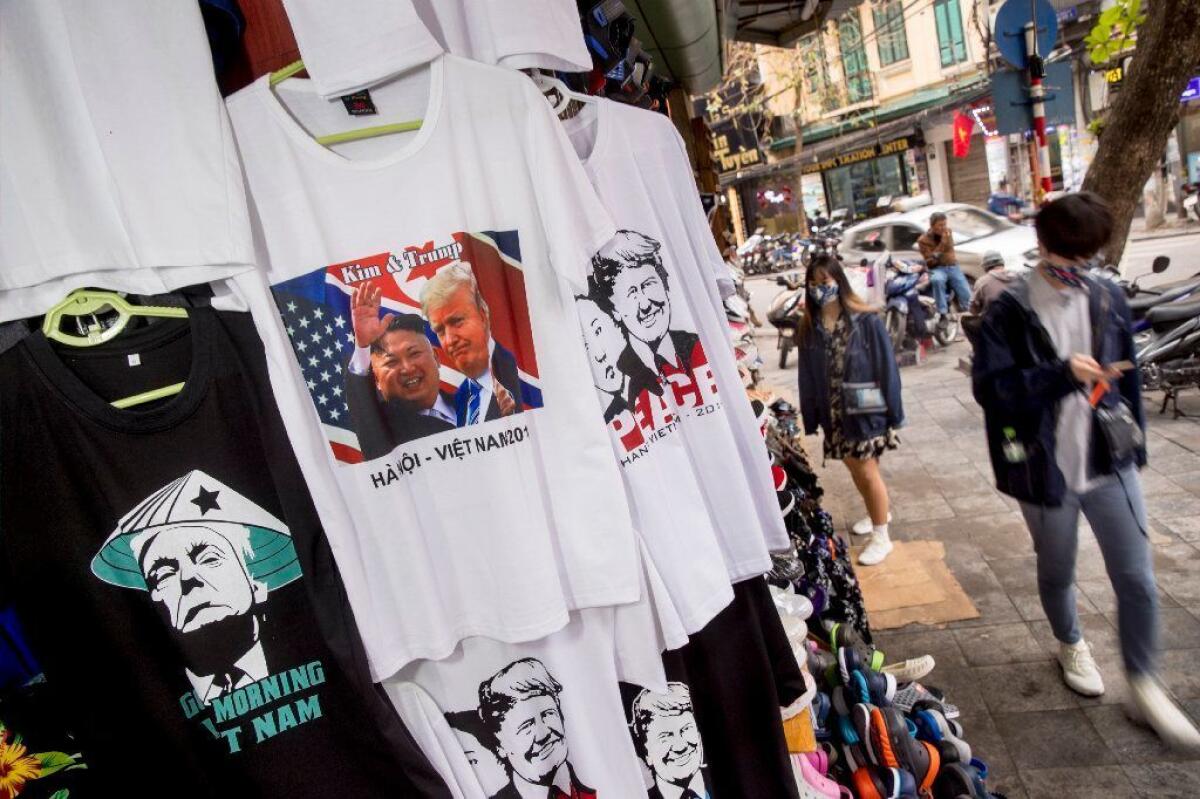
T-shirts bearing the likenesses of Trump and Kim hung from open storefronts. In one second-story workshop, a store owner screen-printed by hand dozens of T-shirts featuring the two leaders’ faces above the word “Peace.”
Outside the D&C art gallery, a 4-foot-high painting of Trump and Kim stood for sale on the sidewalk. The artwork had been commissioned by the gallery owner, Bien Nguyen, less than three weeks ago, after Vietnam was named the summit host.
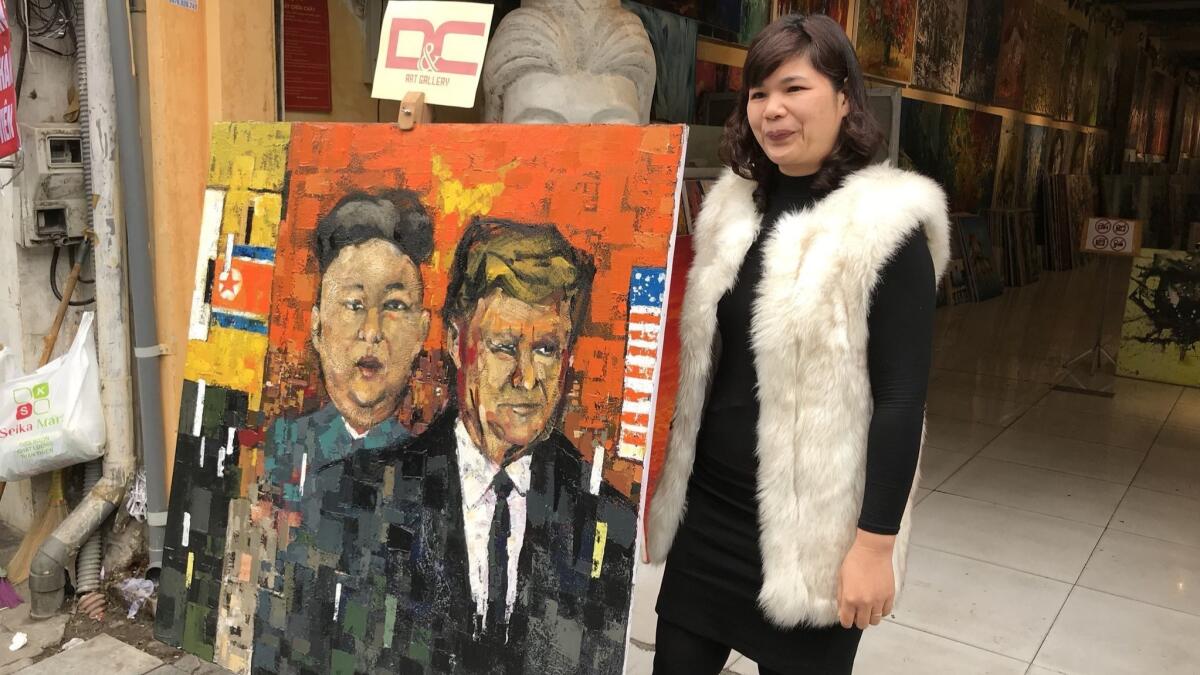
She asked a young artist named Tuan Nguyen, who is no relation, to paint a series of Trump and Kim portraits, each of which were on sale for about $250. Tourists snapped selfies with the dual portrait outside the gallery, but no one had yet made an offer, she said.
Still, the 40-year-old Nguyen had high hopes for what the summit could mean for her country.
“I hope it will bring more investment and tourists to Vietnam,” she said. “This is a beautiful country — that’s why they chose to meet here. We came from war to peace and friendship.”
Times staff writer Victoria Kim contributed to this report.
More to Read
Sign up for Essential California
The most important California stories and recommendations in your inbox every morning.
You may occasionally receive promotional content from the Los Angeles Times.
